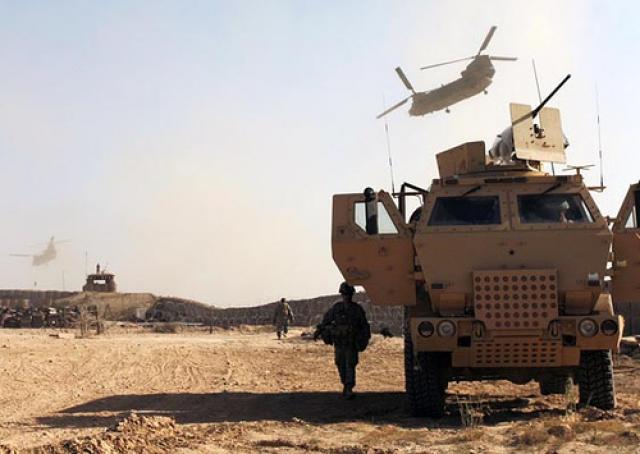The U.S. Army acquisition community is immersed in a series of reforms aimed at improving procurement practices such as streamlining requirements, better managing cost and schedule issues, integrating new technologies before they are sent to theater and working more closely with industry.
Lt. Gen. Bill Phillips, principal military deputy to the assistant secretary of the Army for Acquisition, Logistics and Technology, outlined the reforms Sept. 8 at an Association of the U.S. Army Institute of Land Warfare event in Crystal City.
“There’s not a day that goes by that I don’t think about what we can do to support our Soldiers. As we modernize our Army, we want to put the right capability in the hands of our Soldiers to make sure that they do their missions quickly and safely and come home to their families and friends,” Phillips told the audience.
In particular, Phillips said the Army is implementing as many as 63 of the 76 proposed recommendations emerging from a recently-completed Army Acquisition Review, a holistic study commissioned by the secretary of the Army designed to look at improving the acquisition process.
“Through the Office of the Secretary of the Army we are executing the results of that study. The study did a great job in providing us a blueprint for how to improve our operations,” said Phillips.
In fact, Phillips said the Army has already implemented a series of the recommendations proposed by the study such as working more closely with industry, standing up a deputy assistant secretary of the Army for services and spearheading efforts to reform the Nunn-McCurdy notification process.
Acquiring more technical data packages, conducting testing earlier in the acquisition process and increasing cost-saving multi-year contracts are also among the many recommendations in the Army Acquisition Review currently being implemented by the Army.
Another key aspect of the study which the Army is already working on involves efforts to improve the synchronization of requirements and acquisition procedures at the front end of the process so as to ensure achievable, clearly defined cost and schedule goals, Phillips said.
The Army’s approach to its Ground Combat Vehicle program, which “tiered” requirements with a mind to emphasizing technological maturity, clearly set cost parameters and a seven-year timeline, is an example of this new approach, he added.
In addition, Phillips explained that in some instances requirements established for acquisition programs could be “traded-off” in order to lower costs in today’s more fiscally constrained environment. “We want PMs and PEOs to come forward and let us know what requirements are difficult to produce from a technical perspective. Are we reaching too far or is a certain requirement something that does not make sense?” Phillips said.
Phillips also cited substantial progress through the Army’s Capability Portfolio Review, or CPR process, ongoing initiatives to look across portfolios of systems to gain efficiency and eliminate redundancy where possible. So far, the CPR process has already saved the Army more than $5 billion, he said.
The NIE Process
The Army’s ongoing Network Integration Evaluations, semi-annual exercises at White Sands Missile Range, N.M., designed to evaluate and integrate emerging technologies in a combat-relevant environment before they are sent to combat, are a critical part of the ongoing efforts to reform acquisition, Phillips said.
The Army is already harvesting key lessons learned from its first NIE which finished up in July and is preparing for the next NIE slated to begin in October; the idea is to evaluate and perform key integration on emerging or promising technologies in a realistic test environment before sending systems into theater. This approach ensures that new technologies are properly integrated before being deployed and also helps Army acquisition keep pace with fast-moving technological changes.
“The NIE is really a new way of doing business. It is an effort designed for us to take a system that we would have been testing down range and take it out to White Sands Missile Range and evaluate it in the hands of Soldiers. This allows us to get critical Soldier feedback and improve our programs,” Phillips said. “This is going to be something that we will institutionalize within the Army.”
Plans for the upcoming NIE, which include the evaluation of as many as 53 emerging technologies, were formed in large part due to responses to Army “Sources Sought” notifications asking industry to propose technical solutions designed to address or fill specific network-related capability gaps identified by the Army.
“We got 73 White Papers from industry. We did an evaluation of each White Paper and selected 53 of those systems to be evaluated at the next NIE,” Phillips said. “We are aligning our programs today to be able to fit within the NIE window.”
Partnering with industry in order to identify and develop new technologies able to fill key network capability gaps is a critical part of the NIE process, Phillips emphasized.
New technologies developed or acquired through the Operational Needs Statement or Joint Urgent Operational Needs Statement process will go through NIE testing procedures, said Gen. Peter Chiarelli, Army vice chief of staff.
“The NIE construct is an exercise every six months, involving a fully equipped brigade combat team at Fort Bliss, Texas. That is all they do. We are going to take the integration requirement off of the commander who is fighting and put it on that brigade combat team,” Chiarelli said.
As an example of the importance of Army acquisition, Phillips recounted the story of 1st. Lt. Jason Miller, a Soldier whose life was saved when his Advanced Combat Helmet stopped bullets shot at him by Taliban insurgents in Afghanistan.
“He somersaulted backward. Then he stood up, dusted himself off, grabbed his M4 and killed the two Taliban fighters. Jason Miller is alive today because the process worked,” Phillips told the crowd.











